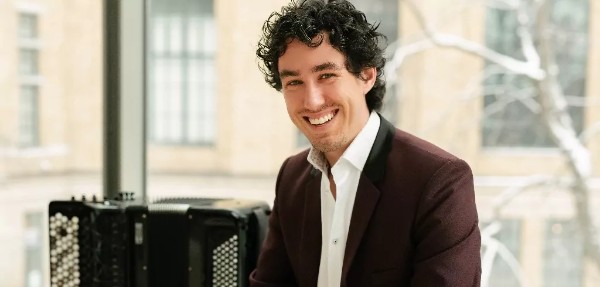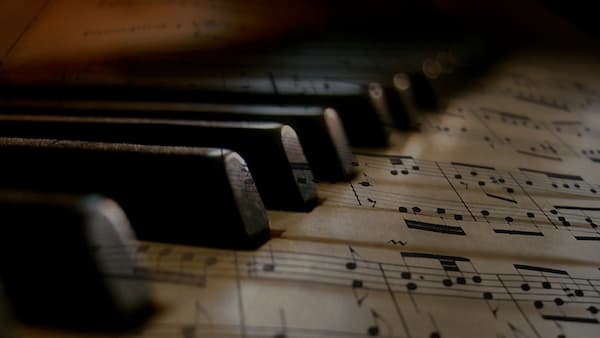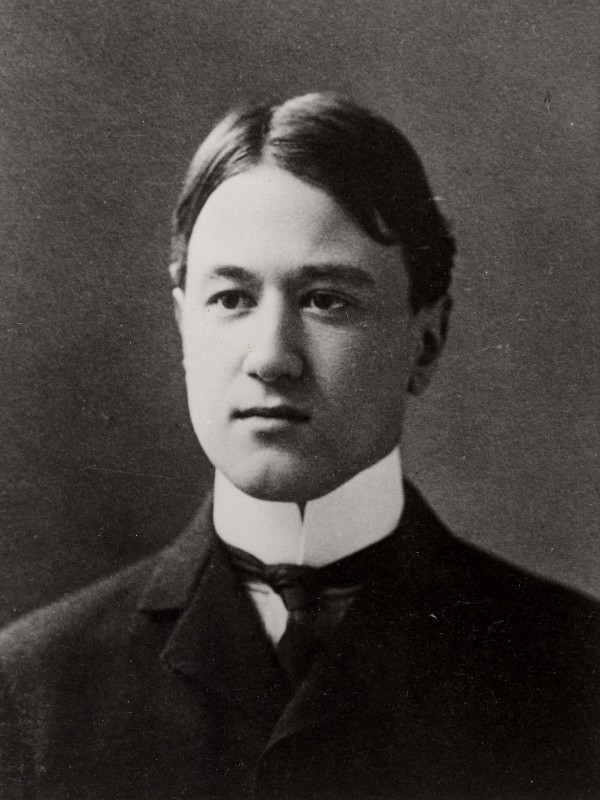Igor Stravinsky’s ballet scores are not mere compositions. They are living and breathing testaments to the depths of human emotion all poured into sound and movement.
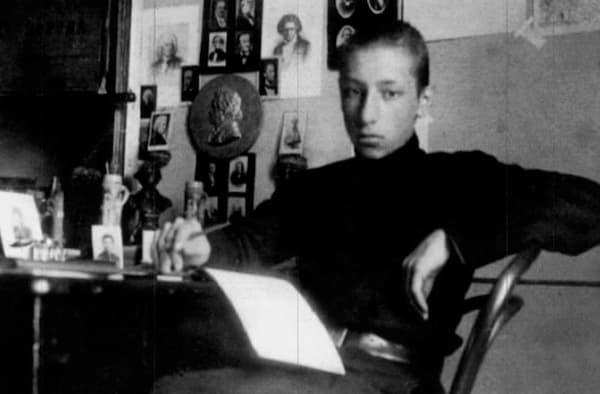
The young Igor Stravinsky
Through his groundbreaking collaborations, particularly with the Ballets Russes, Stravinsky produced some of the most iconic works in the repertoire, weaving a tapestry of sound full of rhythmic complexity and vivid orchestration.
Stravinsky pushed artistic boundaries, blending classical traditions with a modernist flair to craft works that pulse with longing, fury, and ethereal beauty. From explosive premieres that sparked riots to timeless masterpieces that redefined dance, his contributions remain a cornerstone of both music and choreography.
Stravinsky’s genius lies not just in his innovation, but in his ability to make us feel like we want to dance with him through joy, despair, and everything in between. Shall we have a listen to his 5 greatest ballet scores?
The Firebird
Stravinsky composed his first ballet score for a Russian fairy tale centering on a magically glowing bird in 1910. L’Oiseau de feu, better known as the “Firebird” tells the story of Prince Ivan wandering into the enchanted garden of the evil sorcerer Kastchei.
He captures the magical Firebird, who trades her freedom for a feather. When Ivan attempts to rescue Princess Tsarevna, Kastchei unleashes his dark forces to destroy the prince. Ivan summons the Firebird, who returns in a blaze of glory, casting a spell that forces Kastchei’s minions into a frenzied dance until they collapse.
With her power, she reveals the secret to Kastchei’s immortality, which Ivan destroys and thus breaks the sorcerer’s curse. Kastchei perishes, his captives are freed, and Ivan and the Princess unite in a triumphant, tender embrace, their love sealed under the Firebird’s radiant blessing.
The Music

Igor Stravinsky as drawn by Pablo Picasso (dated 31 December 1920). Published in France in May 1921 in the program
for the 14th season of the Ballets Russes at the Théâtre de la Gaîté-Lyrique in Paris
Stravinsky’s score is pure magic, and a love letter to his Russian roots. It is a sonic fairy tale, weaving lush romantic swells with jagged and daring rhythms. It’s dark, shimmering and alive, from the slithering strings that paint Kastchei’s sinister realm to the explosive brass and woodwinds that herald the Firebird’s blazing arrival.
Drenched in folkloric fire and orchestral wizardry, the Firebird theme soars with restless and glittering beauty, while Kastchei’s menace growls through dissonant, bone-rattling chords. The famous “Infernal Dance” is raw energy, while the finale unfurls like a radiant and tender sunrise.
The music is simultaneously chaotic and serene, with pulsating percussion clashing with delicate and mournful melodies. Stravinsky was only 26 when he composed the “Firebird,” but he certainly set the stage ablaze.
The Wedding
Igor Stravinsky composed music for the ballet-cantata “Les Noces” (The Wedding) between 1914 and 1923. It tells the story of a traditional Russian peasant wedding through a blend of music, song, and dance.
The work is structured in four scenes, performed without interruption, and does not focus on individual characters in a conventional narrative sense. Instead, it presents a series of ritualistic episodes typical of a village wedding.
In Scene 1 “The Bride’s House,” the bride is prepared for her wedding as friends and family braid her hair, symbolising her transition from maidenhood. Their ritualistic weeping blends sorrow with ceremony. In Scene 2 “The Groom’s House,” the groom seeks his parents’ blessings, mirroring the bride’s preparations with his friends’ support, emphasising ritual symmetry.
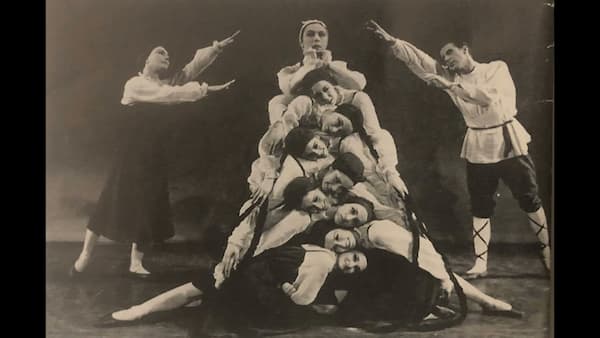
Stravinsky’s Les Noces
Scene 3, “The Bride’s Departure”, shows the bride leaving home amid her mother’s and the groom’s mother’s laments, underscoring the emotional weight of separation. Finally, Scene 4 celebrates “The Wedding Feast” with toasts, drinking songs, and bawdy tales, ending in a joyful yet raw nuptial benediction.
Igor Stravinsky: Les Noces – Scene 3: The Departure of the Bride (Kate Winter, soprano; Linda Seymour, mezzo-soprano; Parry Jones, tenor; Roy Hendersen, bass; Berkeley Mason, piano; Edwin Benbow, piano; Ernest Lush, piano; Leslie Heward, piano; BBC Chorus; Igor Stravinsky, cond.)
Igor Stravinsky: Les Noces – Scene 3: The Wedding Feast (Kate Winter, soprano; Linda Seymour, mezzo-soprano; Parry Jones, tenor; Roy Hendersen, bass; Berkeley Mason, piano; Edwin Benbow, piano; Ernest Lush, piano; Leslie Heward, piano; BBC Chorus; Igor Stravinsky, cond.)
The Music
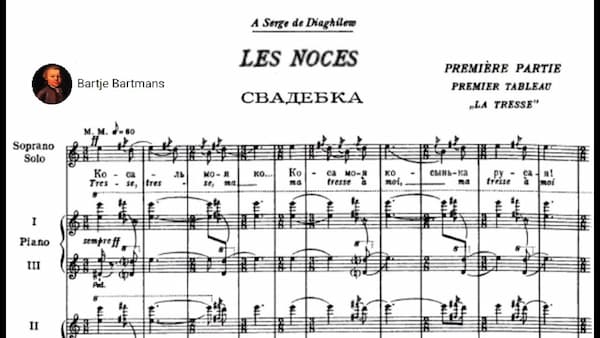
Stravinsky’s Les Noces (The Wedding) music score
Les Noces is not a linear plot but more about capturing the essence of a cultural event through fragmented, archetypal moments. The music is scored for four vocal soloists (soprano, mezzo-soprano, tenor, bass), a mixed chorus, four pianos, and a variety of percussion instruments.
Stravinsky strikingly fuses Russian folk influence with modernist innovation by featuring relentless jagged rhythms and a stark, mechanical texture that evokes the ritualistic essence of a peasant wedding.
The rhythmic intensity and mechanical precision evoke the primal spirit of the ritual rather than a romanticised portrayal, and his use of folk-inspired melodies, paired with his signature dissonance and rhythmic complexity, transforms the traditional into the avant-garde. Some experts claim this to be Stravinsky’s best score.
Petrushka
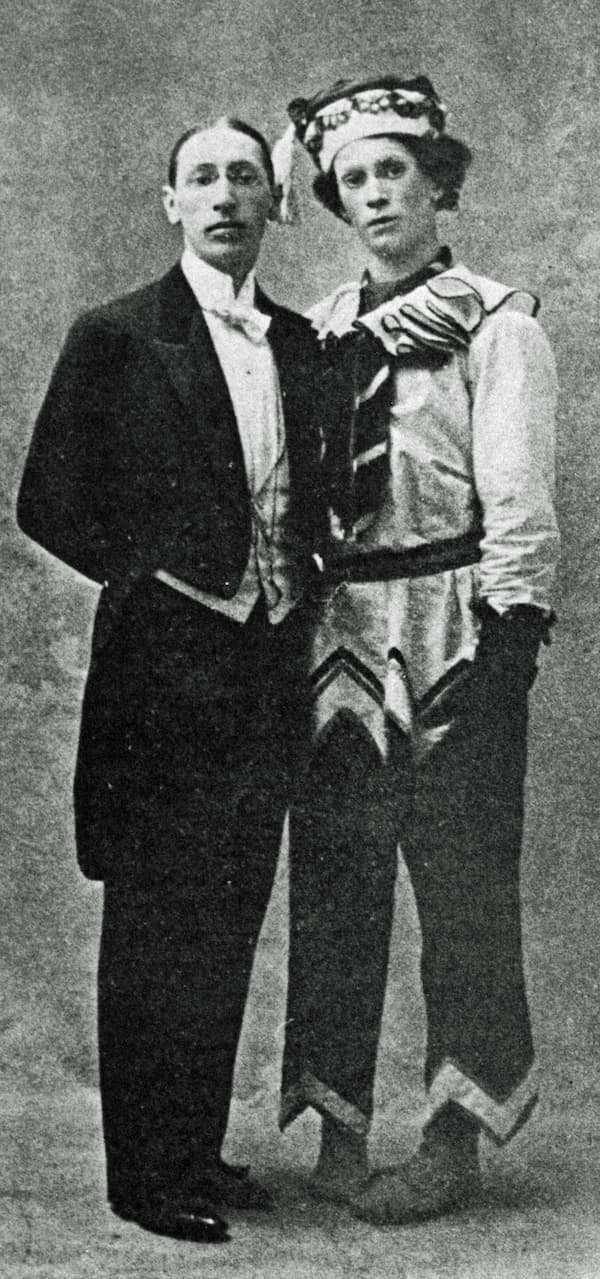
Stravinsky and Nijinsky as Petrushka
Igor Stravinsky: Petrushka – Tableau I: The Shrovetide Fair (Swiss Romande Orchestra; Neeme Järvi, cond.)
Petrushka premiered in 1911 and tells the story of a tragic puppet brought to life during a Russian Shrovetide Fair. Set in 1830s St. Petersburg, the plot unfolds in four tableaux.
It begins with a bustling fair scene where a charismatic Showman animates three puppets: Petrushka, the Ballerina, and the Moor. Petrushka, a clownish figure with a human heart, falls in love with the Ballerina, but she is captivated by the exotic, brutish Moor.
In his cramped cell, Petrushka rages against his confinement and unrequited love. The tension escalates, and the Moor eventually kills Petrushka with a scimitar. As the crowd disperses, Petrushka’s ghost rises above the theatre, mocking the Showman and hinting at his enduring spirit, leaving his fate ambiguous.
Igor Stravinsky: Petrushka – Tableau II: Petrushka’s Room (Swiss Romande Orchestra; Neeme Järvi, cond.)
The Music
The story blends folkloric charm with dark, existential undertones, reflecting Stravinsky’s innovative storytelling and musical score. The music in the “Shrovetide Fair” bursts with lively and colourful energy.
Stravinsky uses bustling rhythms, folk-inspired melodies, and overlapping themes, like the “Russian Dance,” played by a full orchestra with bright woodwinds and brass. The famous “Petrushka chord” emerges as the Showman animates the puppets.
The second Tableau shifts to a claustrophobic and introspective mood. Angular melodies and sharp stabbing rhythms from clarinets and strings reflect Petrushka’s frustration and despair. The “Petrushka chord” is now tinged with pathos, underscoring his trapped and human-like emotion.
Igor Stravinsky: Petrushka – Tableau III: The Moor’s Room (Swiss Romande Orchestra; Neeme Järvi, cond.)
Petrushka Chord
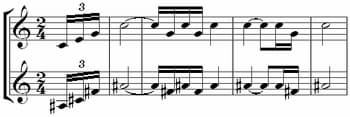
Petrushka Chord
Tableau III is set in the “Moor’s Room,” and the music becomes exotic and sensual, with a slower swaggering rhythm in the low brass. The Ballerina is introduced by a waltz-like theme, and as the music builds tension Petrushka intrudes and everything erupts into a chaotic and dissonant clash.
We now return to the “Shrovetide Fair” in the evening, with the music darker and more frenetic. The orchestra pulses with rhythmic intensity until the Moor’s fatal strike, marked by a brutal, percussive climax. The music softens as Petrushka’s ghost appears, ending with a haunting, ambiguous trill in the trumpets, leaving an eerie resonance.
Petrushka is a vibrant and modernist masterpiece that weaves Russian folk melodies into a dynamic orchestral tapestry. Marked by rhythmic complexity and the dissonant “Petrushka chord,” it vividly captures the ballet’s tragic puppet narrative.
Igor Stravinsky: Petrushka – Tableau IV: The Shrovetide Fair (Swiss Romande Orchestra; Neeme Järvi, cond.)
Apollo
Stravinsky composed Apollo, Leader of the Muses on commission from Elizabeth Sprague Coolidge for a festival of contemporary music in Washington, D.C. It is very different from Stravinsky’s earlier Russian period, as it embraces the clarity and classical ideals inspired by 18th-century French music and dance.
Apollo is a plotless ballet in two tableaux, focusing on the mythological birth and ascendancy of Apollo, the Greek god of music, poetry, and the arts, and his interaction with three Muses.
The Story
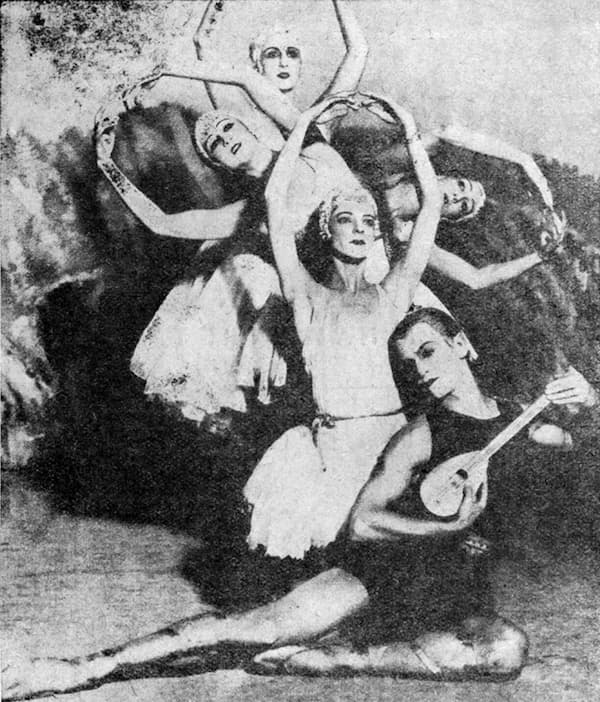
Ballets Russes: Apollo, 1928
The first tableau witnesses the birth of Apollo on the island of Delos. The newborn Apollo is swaddled and cradled by nymphs, symbolising his divine origin. He then emerges mature to claim his lyre, a gift signifying his artistic domination.
The second tableau shifts to Apollo’s encounter with Calliope (Muse of poetry), Polyhymnia (Muse of mime), and Terpsichore (Muse of dance). Apollo first performs a solo dance, and then dances with each Muse.
He tests their gifts with a writing tablet, a mask, and a dance, and the ballet culminates with Apollo united with the Muses in harmonious choreography. He then leads them in an apotheosis, ascending Mount Parnassus to join the gods.
Igor Stravinsky: Apollon musagete, “Apollo” – Tableau I: Prologue: The Birth of Apollo (Columbia Symphony Orchestra; Igor Stravinsky, cond.)
The Music
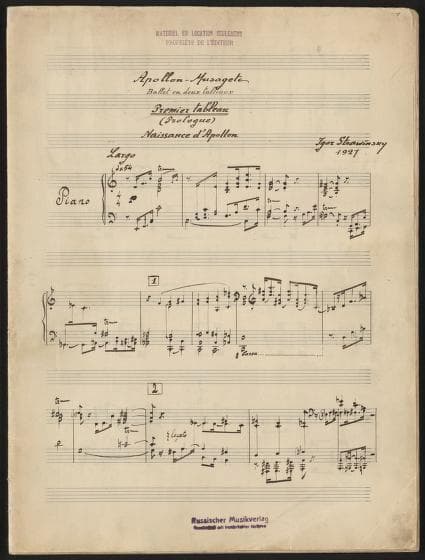
Stravinsky’s Apollo piano score
The narrative, though minimal, uses dance to explore themes of creativity and classical beauty. Stravinsky’s music, scored for string orchestra, embodies a neoclassical style with its elegant, restrained, and lyrical character.
Stravinsky drew his inspiration from French Baroque dance forms, like the sarabande and galliard. Its clear textures and balanced phrasing contrast with his earlier rhythmic complexity, unfolding in serene, flowing melodies that evoke the divine grace and poetic harmony of Apollo and his Muses.
Igor Stravinsky: Apollon musagete, “Apollo” – Tableau II: Pas d’action: Apollo and the Muses (Columbia Symphony Orchestra; Igor Stravinsky, cond.)
Igor Stravinsky: Apollon musagete, “Apollo” – Tableau II: Pas de deux: Apollo and Terpsichore (Columbia Symphony Orchestra; Igor Stravinsky, cond.)
The Rite of Spring
Surely the most famous of the Stravinsky ballets, “Le Sacre du printemps” (The Rite of Spring) premiered on 29 May 1913. The primitive scenario, a setting of scenes from pagan Russia, and the intensely rhythmic score shocked audiences.
It was such a radical departure from classical ballet, with a score full of shattering dissonances, polyrhythms, and primal energy. The premiere famously sparked a riot among the audience.
Apparently, Stravinsky himself was so upset due to its reception that he fled the theatre in mid-scene. However you look at it, it eventually became a concert staple and a pivotal work in 20th-century music. It was a landmark that redefined music and dance.
The Plot
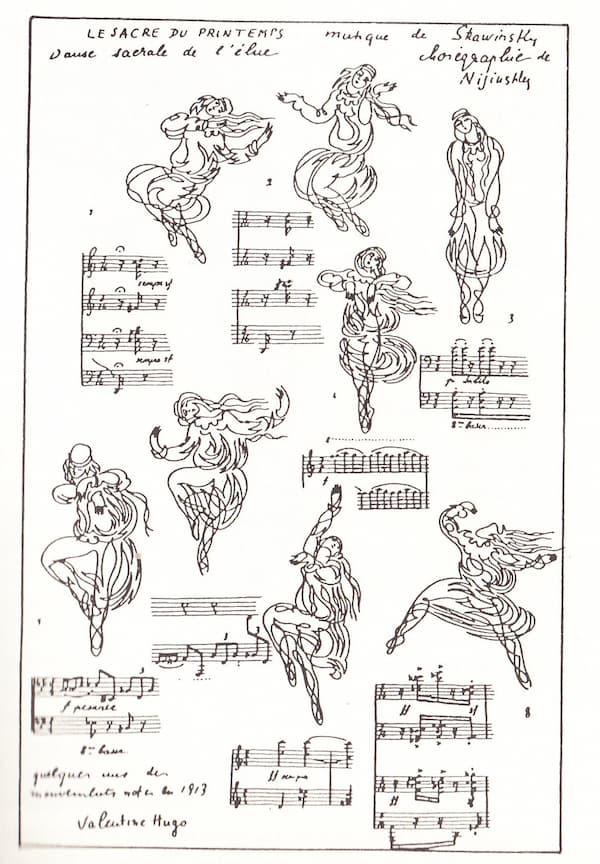
Stravinsky’s The Rite of Spring sacrificial dance
Divided into two parts, the plot depicts an ancient pagan ritual in prehistoric Russia. In “Adoration of the Earth”, tribes gather to celebrate spring with frenzied dances and games and a procession led by the Sage and the Old Man.
In Part 2, a young girl is chosen as the sacrificial victim and dances herself to death to appease the gods and ensure the earth’s fertility. Surrounded by elders and the community, she dies in a climactic and relentless ceremony.
The Music
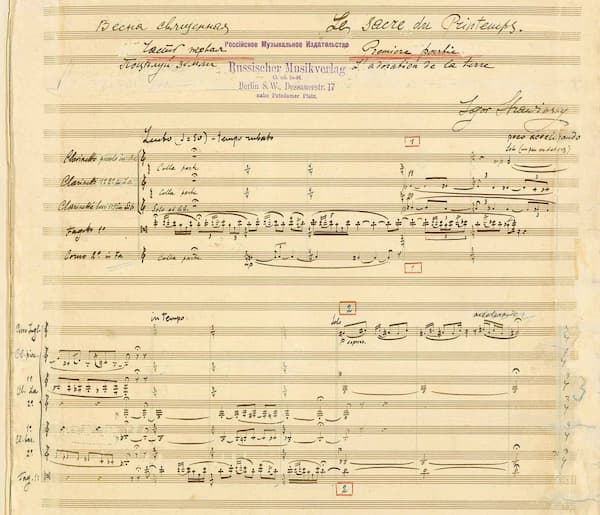
Stravinsky’s The Rite of Spring manuscript
The work is scored for an unusually large orchestra, with a percussion section that was, at the time, the largest for any ballet. Stravinsky generates a wide variety of timbres from this ensemble, beginning the ballet with a very quiet and high bassoon solo, and ending with a frenzied dance played by the whole orchestra.
Stravinsky features melodies inspired by ancient, folklike themes, with the opening solo bassoon tune being the only one he directly acknowledged as borrowed from existing folk music.
The music is harmonically daring, embracing dissonance for its own effect, and rhythmically intense, with shifting time signatures and jarring off-beat accents, embodying a primitivist style.
Legacy
Igor Stravinsky’s five greatest ballet scores highlight his profound impact on 20th-century music. They showcase the evolution of his musical style, ranging from Russian folklore and avant-garde innovations to neo-classical clarity.
These scores transformed music and dance by pushing boundaries of rhythm, harmony, and form. And they greatly inspired generations of composers and choreographers with their innovative power and timeless expressiveness.
For more of the best in classical music, sign up for our E-Newsletter

